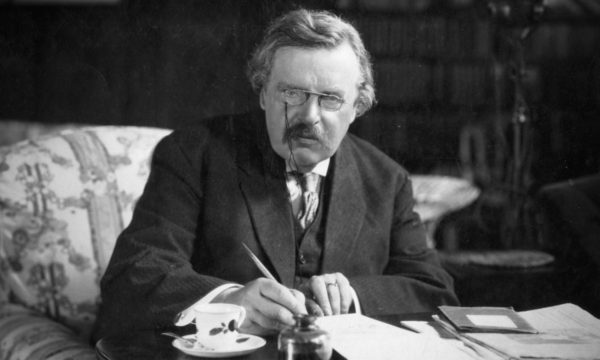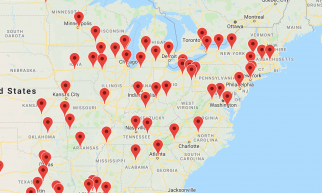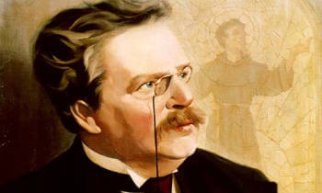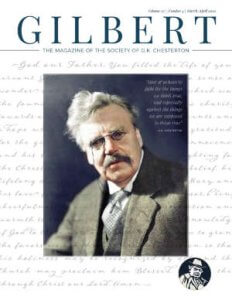Basil Howe—A Story of Young Love
When G.K. Chesterton’s papers were finally being moved to the British Library after sitting in Dorothy Collins’ attic for 50 years, an old trunk was opened. It was thought to contain only musty old academic gowns from Chesterton’s honorary degrees, but underneath them was a treasure of his early, unpublished writings in several notebooks. In one of these notebooks was his first novel. Or most of it. The great Chesterton scholar Denis Conlon managed to find almost all of the missing pages and put the whole story together. The page that he never found was the title page. So it was he who gave the book its present title.
An early, incomplete version of it was published in Volume 20 of the Collected Works in 1993, but the completed book was published separately in 2001, along with Denis’ penetrating introduction and a fascinating and indescribable story called “Our Future Prospects.” The latter was an ensemble piece written in about 1894 by the members of the Junior Debating Club, Chesterton and his schoolboy friends, including Edmund Clerihew Bentley. In this amusing fantasy, they imagine themselves ten years older, having great adventures. The most domesticated of them is none other than Chesterton, who is married to a red-haired girl named Gertrude Gray—although his domestic life is anything but tame, for his wife gets kidnapped by the Russian police, and the heroic members of the JDC dramatically rescue her.
Now how does this wild and rather bizarre tale serve as the introduction to what is essentially a drawing room romance, devoid of any action? Because Gertrude Gray happens to be the name of girl who is wooed by Basil Howe. This indicates that all of his friends had read the manuscript to Chesterton’s novel.
So, if we assume that the character of Basil Howe is based on Chesterton himself—and we do—who is the red-haired girl based on? Denis Conlon makes the very good case that it is Violet Vivian, one of three sisters who lived just down the street from Chesterton in Kensington. In the novel, Basil Howe is attracted to all three of the Grey sisters, just as Chesterton liked all three of the Vivian sisters, but he is especially drawn to the “veritably delightful child with a temper as formless and erratic as her tempest of red hair.” She must have made a lasting impact, for although she disappeared from his life, the red-haired heroine/love interest would continue to appear prominently in his poetry and fiction, even after the arrival of Frances Chesterton—who was a brunette.
Every character in a novel, says Chesterton, is only the novelist in disguise. In Manalive, Innocent Smith is clearly the jolly, fatter, older and wiser Chesterton. Basil Howe is the thin, shy, young, thoughtful but unsure, untested Chesterton. While both are enigmatic and romantic, Innocent Smith runs off with his wife many times over. Basil Howe has yet to run off with his wife the first time.
The Chesterton who is writing Basil Howe is nineteen years old. He is still trying to establish his own style, his own voice. While young writers are creative, they are also imitative. We see elements of Jane Austen, Louisa May Alcott here. Still missing are Dickens and Stevenson. He does not let his imagination take him to the south seas. He only lets it take him as far as the four walls of the home. And only a short distance into the future where he would like to be a married man living within those walls.
Conlon rightly points out that if Basil Howe had been published anonymously, Chesterton would not be the first person to spring to mind as the author. Certainly his philosophy is not yet fully-formed, nor his religion. But there are a few hints that Basil Howe is indeed G.K. Chesterton. He is one who finds something in everyone with which he can agree. He has “a splendid memory.” His shyness is only humility, but he is not afraid to say what he feels is important: “I don’t believe in Great Silent men myself. If a man has really anything to say, anything new or important or amusing, it’s his natural instinct—to get rid of it as soon as possible.”
He is also aware that what he says sounds like nonsense to other people. (“I don’t have an umbrella. The universe is my umbrella.”) He doesn’t mind playing the fool to make them laugh a little. He aspires to be ordinary, which, for him, takes “a heroic effort.” His sympathy lies with the masses and not with the cultured class. He especially cares about “the disregarded.”
Perhaps it is Chesterton’s feelings of being a misfit that have led some to speculate loudly that he was latently homosexual. Of all the lies told about Chesterton, this one is perhaps the most absurd (Yet A.N. Wilson repeated it in an off-handed way just recently in a review of Ian Ker’s biography of Chesterton). But no one can read Basil Howe and not be caught up in the budding and blossoming love between a man and a woman. No one can misconstrue so spectacular a song of the sexes as Basil Howe’s line: “A young man today, in this whirling social cosmos, chased by sins, fretted by doubts, has still one sight which God sends him eternally; the sight which Adam saw when he awoke from sleep.”





